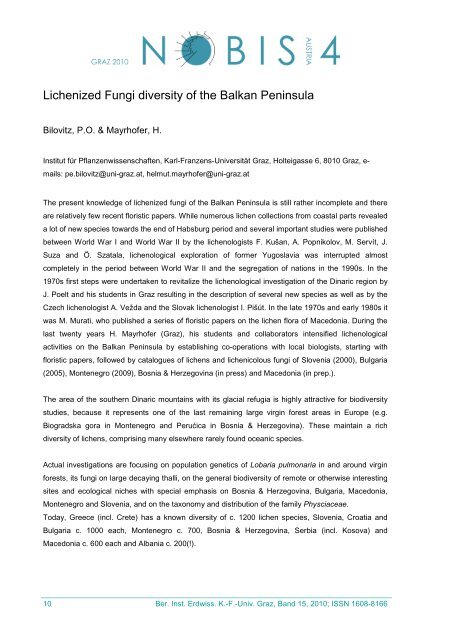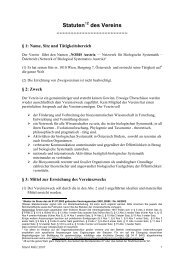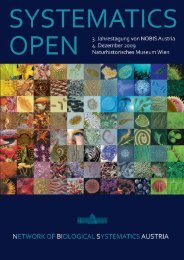4. Jahrestagung von NOBIS Austria 2. - 3. Dezember 2010
4. Jahrestagung von NOBIS Austria 2. - 3. Dezember 2010
4. Jahrestagung von NOBIS Austria 2. - 3. Dezember 2010
You also want an ePaper? Increase the reach of your titles
YUMPU automatically turns print PDFs into web optimized ePapers that Google loves.
Lichenized Fungi diversity of the Balkan Peninsula<br />
Bilovitz, P.O. & Mayrhofer, H.<br />
Institut für Pflanzenwissenschaften, Karl-Franzens-Universität Graz, Holteigasse 6, 8010 Graz, e-<br />
mails: pe.bilovitz@uni-graz.at, helmut.mayrhofer@uni-graz.at<br />
The present knowledge of lichenized fungi of the Balkan Peninsula is still rather incomplete and there<br />
are relatively few recent floristic papers. While numerous lichen collections from coastal parts revealed<br />
a lot of new species towards the end of Habsburg period and several important studies were published<br />
between World War I and World War II by the lichenologists F. Kušan, A. Popnikolov, M. Servít, J.<br />
Suza and Ö. Szatala, lichenological exploration of former Yugoslavia was interrupted almost<br />
completely in the period between World War II and the segregation of nations in the 1990s. In the<br />
1970s first steps were undertaken to revitalize the lichenological investigation of the Dinaric region by<br />
J. Poelt and his students in Graz resulting in the description of several new species as well as by the<br />
Czech lichenologist A. Vežda and the Slovak lichenologist I. Pišút. In the late 1970s and early 1980s it<br />
was M. Murati, who published a series of floristic papers on the lichen flora of Macedonia. During the<br />
last twenty years H. Mayrhofer (Graz), his students and collaborators intensified lichenological<br />
activities on the Balkan Peninsula by establishing co-operations with local biologists, starting with<br />
floristic papers, followed by catalogues of lichens and lichenicolous fungi of Slovenia (2000), Bulgaria<br />
(2005), Montenegro (2009), Bosnia & Herzegovina (in press) and Macedonia (in prep.).<br />
The area of the southern Dinaric mountains with its glacial refugia is highly attractive for biodiversity<br />
studies, because it represents one of the last remaining large virgin forest areas in Europe (e.g.<br />
Biogradska gora in Montenegro and Perućica in Bosnia & Herzegovina). These maintain a rich<br />
diversity of lichens, comprising many elsewhere rarely found oceanic species.<br />
Actual investigations are focusing on population genetics of Lobaria pulmonaria in and around virgin<br />
forests, its fungi on large decaying thalli, on the general biodiversity of remote or otherwise interesting<br />
sites and ecological niches with special emphasis on Bosnia & Herzegovina, Bulgaria, Macedonia,<br />
Montenegro and Slovenia, and on the taxonomy and distribution of the family Physciaceae.<br />
Today, Greece (incl. Crete) has a known diversity of c. 1200 lichen species, Slovenia, Croatia and<br />
Bulgaria c. 1000 each, Montenegro c. 700, Bosnia & Herzegovina, Serbia (incl. Kosova) and<br />
Macedonia c. 600 each and Albania c. 200(!).<br />
_____________________________________________________________________________<br />
10 Ber. Inst. Erdwiss. K.-F.-Univ. Graz, Band 15, <strong>2010</strong>; ISSN 1608-8166






